US ITASE 2001-2002 Discussion and Recommendations for US ITASE 2002-2003
Prepared in the field and submitted by: Paul A. Mayewski Institute for Quaternary and Climate Studies University of Maine On behalf of the 2001-2002 US ITASE traverse team.
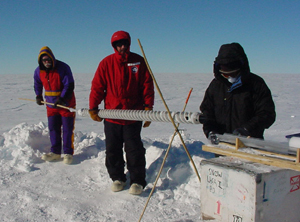 Summary
Summary
During
the third US ITASE field season (2001-2002) the field team traversed1825
km from Byrd to within 125 km of Siple Station and return to Byrd. The
traverse was comprised of 12-14 members, two Challenger 55s and various
heavy and light sleds. The bulk of the JP8 fuel used by the Challengers
was air dropped to three sites along the route. Route selection was based
upon the science objectives of the US ITASE researchers and safe route
selection was aided by examination of RADARSAT images and an onboard crevasse
detection system. Eleven integrated science programs were supported by
US ITASE in 2001-2002. Science was conducted both during travel and at
six sites. Continuous shallow (~120 m) and deep (>3000m) radar over
1800 km comprised the travel component of the science. Near real-time
shallow radar information was used to finely tune the location of six
study sites and to tie these sites together via identification of long
distance subsurface marker horizons. At each site 3" and 2"
diameter ice cores were collected that will provide samples for stable
isotopes, major soluble ions, trace elements, organic acids, b activity,
stratigraphy, porosity, permeability, and density. A total of 771 m of
ice core was collected during the 2001-2002 season exceeding even the
ice core recovery success of the previous US ITASE season. Atmospheric
sampling of surface air and air to a height of 23 km was also conducted
as well as high precision GPS surveys to determine mass balance, ice flow
direction, and ice velocity. As of the 2001-2002 field season US ITASE
is well equipped to undertake its fourth season (2002-2003) to the South
Pole and a new generation of traverses to be proposed in East Antarctica
from South Pole to Northern Victoria Land (2003-2005). Recommendations
that will make US ITASE even more efficient in 2002-2003 are described
in this report with details related to 2001-2002 logistics and science
operations. Several of the major recommendations are highlighted as follows:
1. Upgrades to
the older Challenger 55 to make it par with the new 55.
2. Purchase of two 3000-gallon fuel tanks mounted on a solid sled system
to replace fuel drums for greater efficiency, cost-savings, and safety.
3. Purchase of a fifth Berco or if available from McMurdo another similar
size sled to replace several less durable, lighter sleds. This item
will not be necessary if item (2) is supported.
4. Retention of the New Zealand owned Alanaar sled for at least 2002-2003
as a heavy-duty fuel sled. This item will not be necessary if item (2)
or (3) are supported.
5. A new permanent structure for working on equipment and berthing for
four people to be mounted on an existing Berco.
6. LC-130 support for 2002-2003 is expected to be significantly less
than for 2001-2002.
7. To reduce impact on South Pole Station in 2002-2003 US ITASE plans
to stay 5- 10+ km outside of South Pole at its last work site for the
season. US ITASE also plans to winter vehicles and sleds at this site.
Finally, it is hoped that the success of the US ITASE platform for science
can act as a model for future science logistics (e.g., a roving base
camp, a resupply system for AGO sites, and future traverses in East
and West Antarctica).
Introduction
US ITASE offers the ground-based opportunities of traditional style traverse
travel coupled with the modern technology of GPS, crevasse detecting radar,
satellite communications and multi-disciplinary research. By operating
as an oversnow traverse US ITASE offers scientists the opportunity to
experience the dynamic range of the Antarctic environment. US ITASE also
offers an important interactive venue for research (currently eleven integrated
science projects) similar to that afforded by oceanographic research vessels
and large polar field camps, without the cost of the former or the lack
ofmobility of the latter. More importantly, the combination of disciplines
represented by US ITASE provides a unique, multi-dimensional (x, y, z
and time) view of the ice sheet and its history. In its current four year
cycle, US ITASE will sample the environment of West Antarctica over spatial
scales of >5000 km, depths of >3000 m, heights in the atmosphere
of >20 km, and time periods of several hundred years (sub-annual scale)
to hundreds of thousands of years (millennial scale). During the first
US ITASE field season (1999-2000) team members conducted a short shakedown
program utilizing two Tucker SnoCats. Weather delays in McMurdo resulted
in a short season and only 50% of the program planned for that season
could be completed. During the second US ITASE field season (2000-2001)
one Tucker SnoCat and one Caterpillar Challenger 55 were utilized. The
SnoCat engine failed early in the season. After hauling the SnoCat back
to Byrd Surface Camp loads were double-shuttled by the Challenger for
the remainder of the season. By season’s end all of the work not
completed during the 1999-2000 season was accomplished and ~90% of the
2000-2001 tasks were completed. This report documents the accomplishments
and recommendations of the 2001-2002 field season.
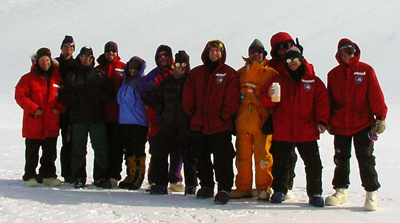
Members of the 2001-2002 US ITASE Field Team
- Steve Arcone (CRREL) – PI surface radar
- *Allen Delaney (CRREL) – Technician surface radar
- Daniel Dixon (U Maine) Graduate student glaciochemistry, snowpit physical studies
- #Jan French - TEA
- Markus Frey (U Arizona) – Graduate student air/snow chemistry
- Cobi Harris (Raytheon) – Field safety officer/food manager
- *Gordon Hamilton (U Maine) – PI surface glaciology
- Susan Kaspari (U Maine) – Graduate student glaciochemistry
- Paul Mayewski (U Maine) – Field Leader, PI glaciochemistry
- *Tom Neumann (U Washington) – Graduate student, stable isotopes
- Steve Niles (Raytheon) – Camp Manager
- Lynn Peters (Raytheon) - Mechanic
- *David Schneider (U Washington) – Graduate student stable isotopes
- Vandy Spikes (U Maine) – Graduate student surface glaciology
- Brian Welch (St. Olaf College) – Post-doc deep radar
- Mark Wumkes (Glacier Data and Ice Core Drilling Services) – Ice core driller
* partial field season
# unable to accompany field team due to injury sustained in McMurdo during
recreational trip
Brief Description of US ITASE 2001-2002 LogisticActivities
During the 2001-2002 season the US ITASE traverse included:
- 12-14 members (depending upon time of the season)
- the Challenger 55 used on the 2000-2001 season
- a new Challenger 55
- one Alandaar sled borrowed from Scott Base for carrying fuel
- one Berco sled with a permanent shelter configured with 9 berths and space for science activities
- one Berco sled with a permanent shelter configured as a kitchen and berthing for up to 4 people
- one Berco sled to carry ice cores and scientific equipment
- one Polar Haven mounted on a Berco sled for use as a mechanic workspace and berthing for 2-3 people
- an assortment of smaller sleds (e.g., 2 Maudheims, one Polar Associate, 2 Nansens and five Komatiks)
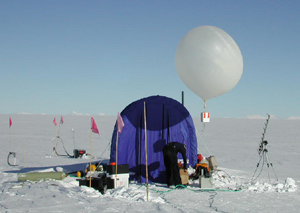 Two
LC-130 fuel drops were made early in the season to provide JP8 fuel for
the traverse. The traverse route planned for 2001-2002 extended 2000 km
from Byrd Surface Camp to Siple Station and return. Early in the season
it was decided to revise the number of site visits from 7 to 6 (deleting
the farthest site Siple Station) changing the total traverse distance
to 1825 km because of initial concerns over fuel consumption. By later
in the season, however, we determined that the estimated fuel consumption
estimate was correct and there would have been sufficient fuel for the
originally planned traverse. As it turned out issues related to terrain
and weather played the key role in determining the farthest point reached
by the traverse. The farthest point reached by the traverse was 50 km
short of site 6 and a straight-line distance of ~125 km from Siple Station.
At this point sastrugi were encountered that were sufficiently large (~1m)
to cause the sleds to heel to the point at which damage could occur to
the structures on the sleds. To avoid damage to people, scientific equipment,
and traverse equipment travel was limited to ~ 5km/hr (compared to usual
travel speeds of 10-12 km/hr). We were unfortunate enough to also have
encountered the sastrugi in flat light conditions limiting our ability
to make detours around the sastrugi. Once stopped we experienced two storms
that lasted a total of four days, with 30-65 knot winds that resulted
in snowdrifts as high as 3m around vehicles and sleds. Forecasts provided
by McMurdo indicated that we should expect at least one more storm after
a short 24-36 lull between storms. We conducted as much science as possible
and extricated the traverse line during the lull between the storms and
began our 825 km return trip to Byrd. By this stage we had completed almost
90% of the traverse, and almost all of the science objectives. We decided
that it was not worth pushing the traverse through poor conditions at
the extreme limit of its distance from McMurdo Station.
Two
LC-130 fuel drops were made early in the season to provide JP8 fuel for
the traverse. The traverse route planned for 2001-2002 extended 2000 km
from Byrd Surface Camp to Siple Station and return. Early in the season
it was decided to revise the number of site visits from 7 to 6 (deleting
the farthest site Siple Station) changing the total traverse distance
to 1825 km because of initial concerns over fuel consumption. By later
in the season, however, we determined that the estimated fuel consumption
estimate was correct and there would have been sufficient fuel for the
originally planned traverse. As it turned out issues related to terrain
and weather played the key role in determining the farthest point reached
by the traverse. The farthest point reached by the traverse was 50 km
short of site 6 and a straight-line distance of ~125 km from Siple Station.
At this point sastrugi were encountered that were sufficiently large (~1m)
to cause the sleds to heel to the point at which damage could occur to
the structures on the sleds. To avoid damage to people, scientific equipment,
and traverse equipment travel was limited to ~ 5km/hr (compared to usual
travel speeds of 10-12 km/hr). We were unfortunate enough to also have
encountered the sastrugi in flat light conditions limiting our ability
to make detours around the sastrugi. Once stopped we experienced two storms
that lasted a total of four days, with 30-65 knot winds that resulted
in snowdrifts as high as 3m around vehicles and sleds. Forecasts provided
by McMurdo indicated that we should expect at least one more storm after
a short 24-36 lull between storms. We conducted as much science as possible
and extricated the traverse line during the lull between the storms and
began our 825 km return trip to Byrd. By this stage we had completed almost
90% of the traverse, and almost all of the science objectives. We decided
that it was not worth pushing the traverse through poor conditions at
the extreme limit of its distance from McMurdo Station.
Two LC-130 fuel drops were made early in the season to provide JP8 fuel
for the traverse. The traverse route planned for 2001-2002 extended 2000
km from Byrd Surface Camp to Siple Station and return. Early in the season
it was decided to revise the number of site visits from 7 to 6 (deleting
the farthest site ˆ Siple Station) changing the total traverse distance
to 1825 km because of initial concerns over fuel consumption. By later
in the season, however, we determined that the fuel consumption estimate
was correct and there would have been sufficient fuel for the originally
planned traverse. As it turned out issues related to terrain and weather
played the key role in determining the farthest point reached by the traverse.
The farthest point reached by the traverse was 50 km short of site 6 and
a straight-line distance of ~125 km from Siple Station. At this point
sastrugi were encountered that were sufficiently large (~1m) to cause
the sleds to heel to the point at which damage could occur to the structures
on the sleds. To avoid damage to people, scientific equipment, and traverse
equipment travel was limited to ~ 5 km/hr (compared to usual travel speeds
of 10-12 km/hr). We were unfortunate enough to also have encountered the
sastrugi in flat light conditions limiting our ability to make detours
around the sastrugi. Once stopped we experienced two storms that lasted
a total of four days, with 30-65 knot winds that resulted in snowdrifts
as high as 3m around vehicles and sleds. Forecasts provided by McMurdo
indicated that we should expect at least one more storm after a short
24-36 lull between storms. We conducted as much science as possible and
extricated the traverse line during the lull between the storms and began
our 825 km return trip to Byrd. By this stage we had completed almost
90% of the traverse, and almost all of the science objectives. We decided
that it was not worth pushing the traverse through poor conditions at
the extreme limit of its distance from McMurdo Station.
Major Scientific and Logistical Accomplishments of the 2001-2002 Field Season
Between 16 November 2001 when the US ITASE team arrived at Byrd and 4
January 2002 when the team departed the field the following major scientific
and logistic goals were accomplished:
(1) Two Challenger 55s traversed a total of 1825 km on the main traverse
and ~200 km of day trips.
(2) Continuous radar observations (crevasse detection (400 MHz), shallow
depth (400 MHz), deep (2.5 MHz)) were made over the 1825 km of the main
traverse route and ~200 km of day trips. In addition, intermediate depth
radar (100 and 12.5 MHz) data were collected over 200 km.
(3) Six out of the original seven projected science sites were occupied
for periods of 2-6 days depending upon workload per site.
Site |
Latitude |
Longitude |
Elevation |
Ice Cores 1 |
|
1 |
79.09ƒ 34.99" |
104.58ƒ 01.98" |
1842 m |
73.164 m |
|
2 |
77.50ƒ 37.01" |
102.54ƒ 37.41" |
1353 m |
71.149 m |
|
3 |
78.07ƒ 12.79" |
95.38ƒ 46.73" |
1633 m |
70.964 m (1) |
70.008 m (2) |
4 |
77.36ƒ 41.93" |
92.14ƒ 54.08" |
1484 m |
68.198 m |
|
5 (2) |
77.03ƒ33.59" |
89.08ƒ 15.28" |
1246 m |
114.726 m |
|
6 (3) |
76.05ƒ50.59 |
89.01ƒ 03.98" |
1240 m |
18.00 m 4 |
Notes:
1) only primary cores listed here.
2) 12 km from the original site 5 (new location determined from surface
radar.
3) 50 km from the original site 6.
4) depth limited due to drill circuitry failure produced as a consequence
of moisture penetrating circuitry housing during storm.
- A total of 771 m of ice cores were recovered utilizing both the 3" diameter Eclipse drill purchased by NSF for use by US ITASE and a 2.2" diameter lightweight drill built by Glacier Data for the University of Maine. A total of seven 3" diameter ice cores were collected from six sites. Ice cores will be sampled for chemistry, stable isotopes, density and total b activity in lieu of snow pits.
- Permeability and porosity experiments were conducted from two snow pits and two 18 m ice cores were collected for this purpose. One more snowpit and an 18 m core were planned for Site 6 but were not collected due to conditions encountered at Site 6.
- Stratigraphy was sampled at sites 1-5 utilizing snow pits excavated either exclusively for this purpose, snow pits excavated as access for 3" ice coring, or ~10 m wide pits excavated using a Challenger 55.
- Twenty-one days of atmospheric and shallow chemistry observations were conducted at five sites. This sampling included real-time, continuous observations of peroxides (H2O2 and organic peroxides), formaldehyde and ozone near surface and ozone profiles up to an altitude of 23 km. 2"-cores (3 m length) from 3 sites were analyzed for H2O2 and HCHO on site using a continuous flow analysis melter system.
- Basic meteorological observations were collected at all sites and 10 m depth temperatures for comparison with infrared satellite estimates of mean annual temperature.
- Six high precision GPS 'coffee can'‚ experiments were deployed to measure mass balance.
Details of the 2001-2002 Traverse and Recommendations for Future
Improvements
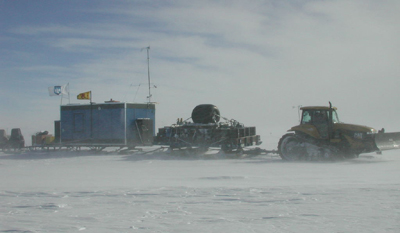
The information presented below does not guarantee perfect US ITASE seasons
in the future, however, it is intended to be an important step in the
evolution of research style oversnow traverse capability. Several discussion
items follow. They represent the combined thoughts of the members of the
US ITASE 2001-2002 traverse. They are offered as a starting point for
discussions with OPP/NSF and Raytheon concerning the 2002-2003 field season.
Heavy Over snow Vehicles US ITASE operated with two Challenger 55s during
the 2001-2002 season. Each vehicle pulled between 30,000 and 45,000 lb..
Both vehicles performed extremely well, requiring only routine maintenance
(oil changes, filters, and steering alignment). The Challenger used during
the 2000-2001 season required replacement of 3 bogie wheels. US ITASE
was also fortunate to have two skilled mechanics on the traverse. One
also served as Camp Manager. The addition of a second mechanic for this
season was particularly valuable.
Heavy Over snow Vehicle Recommendations for 2002-2003:
(1) A second mechanic's position should be maintained for future US ITASE
traverses.
(2) The older Challenger should be fitted with factory available wider
tracks to decrease vehicle ground pressure and increase access to tracks
and under body similar to the newer Challenger.
(3) The older Challenger should be fitted with a rear winch and cable,
heavy-duty hitch, and counter weights similar to the newer Challenger.
(4) The older Challenger should be fitted with a VHF base station similar
to the newer Challenger.
(5) Blockage problems for engine screens in freezing fog and diamond dust
conditions should be investigated to prevent overheating and 1-3 km frequency
stops to clear screens in fog conditions. This may be resolved through
the addition of pusher fans or reversible fans.
(6) Tooling will be required to change fuel settings for the higher altitudes
encountered on the traverse to South Pole.
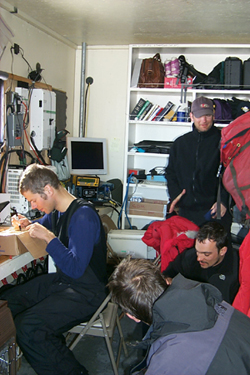 Heavy
Over snow Sleds and Permanent Shelters
Heavy
Over snow Sleds and Permanent Shelters
Four Berco sleds (3000 lb. each) and one Alandaar sled (6000 lb.) were
used during the 2001-2002 season. A description of the use for each follows:
(1) Berco 1 ("Blue Room") serves as a science facility (warm
space for computers and wet chemistry preparation) plus berthing for up
to 9 people. The Blue Room has a solar/wind powered 12 volt system with
a bank of 10 batteries.
(2) Berco 2 affords kitchen space. Seating for 14-15 is possible during
special dinners, and up to 10 "comfortably" on a routine basis.
The kitchen also offers berthing for 4 people. The kitchen has a solar/wind
powered 24 volt system with a bank of 10 batteries.
(3) Berco 3 was fitted at Byrd with a Polar Haven left over from the two
previous US ITASE seasons. It provided space for work on mechanical, ice
coring, and radar equipment, berthing for 3 people, and overflow space
for dining.
(4) Berco 4 provides space for 100+ ice core boxes (= 900+m+ of 3"
ice core) plus some science cargo. The new ice core freezer intended for
the 2001-2002 season did not arrive in McMurdo in time for transport to
the traverse necessitating burial of ice cores at each drilling site to
maintain temperature and collection on the return leg to Byrd.
(5) The Alandaar sled loaned to NSF by Scott Base in 2000-2001 to temporarily
replace a Berco not available at that time was used as a fuel sled during
the 2001-2002 traverse.
Heavy
Over snow Sled and Permanent Shelter Recommendations for 2002-2003:
(1) The Alandaar sled proved to be an excellent, if not essential sled,
carrying 50+ fuel drums, 6 100 lb propane cylinders, and various other
items. We hope it will be possible to keep this sled for the 2002-2003
traverse. It is not clear that the Berco sleds could have transported
this load.
(2) Retain the Polar Haven mounted on Berco 3 as a workshop and berthing
space. More ideally replace the Polar Haven with another permanent shelter
that provides a warm workspace and berthing for four people. The additional
berthing will relieve the crowded berthing for nine in the Blue Room.
The Polar Haven was a last minute addition to US ITASE and proved to be
extremely valuable. Its value will be even greater on the traverse to
South Pole. We also suggest the addition of a two panel solar array, with
two new 12 volt batteries to power an existing 1800 watt inverter.
(3) VHF base stations should be installed in Bercos 1, 2, and 3 to eliminate
the need for constant recharging of batteries in the portable VH Fs. While
traveling it is essential that all sleds carrying people can communicate.
(4) Addition of a fifth Berco for the coming season would aid greatly
in the transport and recovery of fuel barrels and scientific equipment.
Over the past three US ITASE seasons the traverse has been gradually streamlined
to reduce the number and variety of sleds. One more Berco would allow
further streamlining. If another Berco is not available another similar
size sled from McMurdo is requested.
(5) With one season of experience using the kitchen Berco some small modifications
can be suggested such as:
(a) Place outside water melter in an insulated box (this could be the
old black water box initially used in 1999-2000 to store water).
(b) Replace the ships two-burner stove with a four-burner stove and oven
to create more counter space.
(6) Blue Room shelter requires some structural work and caulking after
two seasons of traverse.
(7) Cargo roller frames (20‚) are requested for the Berco sleds to
aid in unloading T-3 and T-4 pallet assemblies from C-130s.
Snowmobiles
Two snowmobiles were used during the 2001-2002 season. Both were older
when first used by US ITASE in 1999-2000.
Snowmobile Recommendations for 2002-2003:
(1) Two replacement snowmobiles are requested for 2002-2003. Considering
the low temperatures to be encountered during the traverse to South Pole
we would prefer to have either two Yamaha VK540s or two rebuilt Alpine
II, but not Skandics.
Fuel and
Power
Several types of fuel were utilized during the 2001-2002 season:
(1) Quantity 120, 55 gal drums of JP8 for the Challenger 55s to travel
~2000 km. During the 2000-2001 traverse fuel consumption was ~.75 km/gal.
(an average of heavy loads and return light loads). The 2001-2002 traverse
assumed .75 km/gal. plus ten extra drums. Using as a basis for fuel consumption
the heavier loads towed in 2001-2002 and the need for small extra fuel
supplies to do side trips an estimate of .6 km/gal. yield a greater margin
of error for future fuel consumption estimates. In addition most of the
2002-2003 traverse from Byrd to South Pole will be uphill suggesting that
.6 km/gal. should be a reasonable estimate for next season.
(2) Quantity 22, 55 gal drums of Mogas for snowmobiles and five generators.
(3) Quantity 12, 100 lb. propane cylinders for heating the Blue Room.
Kitchen, and Polar Haven and for cooking.
(4) Quantity 22 gallons of white gas were on board as back up for propane
stoves but were not used.
(5) Generators were used during 2001-2002 season for melting water, drilling,
24-hr onsite atmospheric chemistry measurements and radar experiments.
One Herman Nelson was used for thawing motors.
Fuel and Power Recommendations for 2002-2003:
(1) The Mogas estimate for 2001-2002 was greatly in excess of the usage.
A total of 10 drums of Mogas should be sufficient for 2002-2003. This
estimate is based on 5 gal/day for melting the 20 gallons of water required
by the team (total 250 gallons for 50 days), 150 gallons for other generators
(ice coring, radar, atmospheric sampling), plus 100 gallons for snowmobiles.
Total 500 gallons + 10 drums.
(2) Assuming .6 km/gal. JP8 and an estimated main traverse length from
Byrd to South Pole of 1400 km a total of 93 drums will be required for
the two Challengers plus 7 spare for a total of 100 drums.
Special Note: The 120 drums of JP8 handled in 2002-2002 and the 100 drums
planned for 2002-2003 require considerable handling. 100 empty drums weigh
a minimum of 5000 lb. and the drums are handled many times (e.g., loading
onto aircraft, offloaded on ground or airdrop, at each airdrop site, shifting
empty for full drums on sleds, retrograding). As a solution to all of
the handling of drums we suggest that each Challenger have a sled dedicated
solely to fuel. Each fuel sled would have a 3000 gallon fuel tank integrally
attached to a sled. The tanks could be directly filled from LC-130 wing
tanks reducing the need for any JP8 drums. If each sled tank contained
3000 gallons, each Challenger could travel 1800 km (assuming .6 km/ gal.).
Challengers could be fueled directly from the tanks utilizing ~20 ft lines.Cost
savings for the tank sleds could be substantial even in the first year
of usage. In 2001-2002 it took 4 LC-130 flights to handle fuel. One flight
to put-in fuel at Byrd to start traverse, two flights to air drop fuel
and one flight to retrograde drums. Using fuel tanks only two LC-130 flights
would be required.Labor would be greatly reduced by conversion to fuel
tanks as noted above.Overall using fuel tanks versus drums would increase
safety. At present fueling is done by people scrambling around on snow
covered fuel drums that are several feet above ground on sleds.
(3) Quantity 12,100 lb propane cylinders will be required for 2002-2003.
(4) White gas supplies remaining from 2001-2002 will be sufficient for
2002-2003.
(5) One Herman Nelson.
(6) Generators:
5 kw for melting water
5 kw for ice core drilling
4 kw Welderator
3.5 kw for atmospheric sampling
1.8 kw for deep radar
1.8 kw to heat atmospheric sampling shelter
2x 0.65 kw for shallow radar
(7) 18 volt cordless combination circular saw-screw gun-reciprocating
saw.
Air Support including Fuel Drops:
A total of 11 LC-130 flights were dedicated to US ITASE in 2001-2002.
The number of LC-130 flights required for 2002-2003 could be reduced.
One Twin Otter flight came to US ITASE in 2001-2002. It transported resupply
items, one team member, and returned three team members to McMurdo. Five
days of Twin Otter close support were used by Hamilton for 2001-2002 to
resurvey sites emplaced in 1999-2000 and 2000-2001. JP8 fuel caches were
placed by the traverse during the 2001-2002 season at two sites to assist
with Twin Otter flights required for resurvey of 2001-2002 GPS installations
during the 2002-2003 season. JP8 for 2002-2003 Twin Otter usage was cached
at:
Site 3 (6 drums of JP8) - 78.07ƒ 14" S, 095.39ƒ 12" W
Site 5 (8 drums of JP8) ˆ 76.59ƒ 52" S, 088.49ƒ 12" W
Two LC-130 fuel drops were dedicated to US ITASE in 2001-2002. A total
of 25 pallets (4 drums of JP8/pallet) were air dropped at sites along
the traverse route. The 109th ANG did a superb job of placing the fuel
drops at sites planned for scientific activities. All drops landed exactly
on target and the drums were in excellent condition. Airdrops most definitely
provide an excellent way to avoid carrying large amounts of fuel and burning
fuel to carry fuel. Airdrops will certainly be an important part of our
plan for 2002-2003.
Air Support Recommendations for 2002-2003:
(1) One Twin Otter flight for Byrd put-in crew (4 people) instead of an
LC-130 put-in.
(2) Two or three LC-130 put-in flights for cargo and science team.
(3) One LC-130 air drop (2-4 sites) of JP8 (14 pallets of 4 drums each
= 64 drums out of 100 total JP8 drums requested (36 drums of JP8 to be
carried from Byrd). Not necessary if fuel tank sleds available for 2002-2003.
(4) All retro for season can be accomplished utilizing return flights
from South Pole.
(5) Twin Otter time to be requested for GPS resurvey, end of season.
Light Sleds:
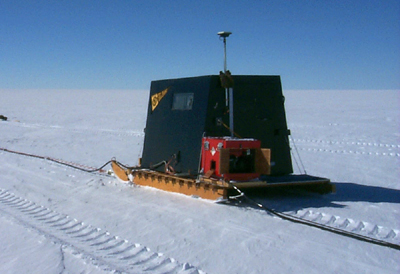 A variety
of light weight sleds were employed in 2001-2002 including:
A variety
of light weight sleds were employed in 2001-2002 including:
(1) two Nansen sleds for camp activities and snowmobile work
(2) one Maudheim for the ice core drill and ice core sampling equipment
(3) one Polar Associate to carry snowmobiles
(4) one Maudheim for tools, Herman Nelson, Challenger spares and fluids
(5) one Komatik for deep radar (Pope Mobile)
(6) one Komatik for 2" ice core drill
(7) one Komatik for Polar Pooper
(8) one Komatik for empty drums and science cargo
(9) one Komatik for the ATM shelter
Light Sled Recommendations for 2002-2003:
(1) Pope Mobile tie downs for Komatik (shelter to sled & generator
to sled attachments) require refitting and strengthening. It may be preferable
to trade the current Pope Mobile Komatik for the 10’ x 20’ science/fuel
drum Komatik to allow increased stability over sastrugi. This assumes
that another Berco or similar sled will replace the science/fuel drum
Komatik.
(2) Empty drum and 2" ice core drill Komatiks require rear fixed
tow bars and strengthened tie down sites.
(3) Empty drum Komatik requires strengthening to avoid lateral movement
and shifting of loads or replacement with a new Berco sled.
(4) ATM shelter Komatik performed well on traverse. The Weather Haven
serves well as a lab/work space but requires a Velcro window (.5m x .5m)
to allow for enough light.
Ice Core Freezer:
The new ice core freezer planned for 2001-2002 did not arrive in McMurdo
in time for transport to the traverse. Cores were cached at sites and
recovered on return trip to Byrd.
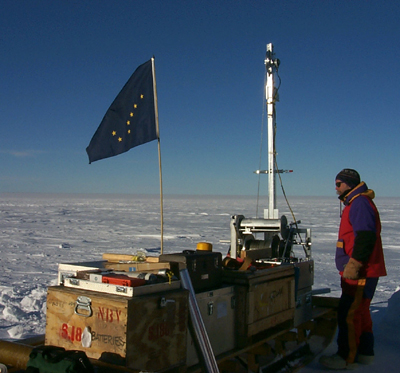 Ice
Core Freezer Recommendations for 2002-2003:
Ice
Core Freezer Recommendations for 2002-2003:
(1) Cold conditions during the 2002-2003 trip to South Pole alleviate
the necessity for an ice core freezer.
Ice Coring Equipment
The primary drill used for the 2000-2001 and 2001-2002 seasons was the
Icefield Instruments Eclipse 3‚‚ ice drill first used by US
ITASE in 1999-2000. Overall performance was excellent with minor mechanical
breakdowns. It offers notable logistic advantages that make it particularly
useful for field traverse programs. It is lightweight and can be easily
transported on a dedicated Maudheim sled, without complete disassembly.
It takes a 3" diameter core and therefore requires fewer core boxes
to transport and store the core than the standard 4" PICO drill.
Eclipse ice core quality was excellent throughout all drilling depths
making processing easier. ICDS supported valuable modifications to the
Eclipse drill and provided a highly experienced driller.A new 2"
ice core drill (Rongbuk) designed by Glacier Data was introduced this
season. The Rongbuk drill was purchased by the University of Maine and
utilized by several US ITASE projects. It was used in conjunction with
the Eclipse to reduce time on site. Even in its prototype form the Rongbuk
provided excellent samples in lieu of snow pits as well as shallow drilling
to 20+ m.
Further modifications should result in the Rongbuk being capable of drilling
to depths of ~100m.
Ice Coring Equipment Recommendations for 2002-2003:
(1) It is essential to have an experienced driller on US ITASE traverses.
(2) Interest in the Rongbuk is large enough to solicit NSF support for
a dedicated version.
(3) Four 12 volt, 100 amp hour gel cells.
(4) 100 foot 10 gauge extension cord with a four-plex box on the end.
(5) 48 volt photovoltaic array and charge regulator for 2 inch drill.
(6) Request to ICDS for a drill rescue kit to include 75m of 0.5"
diameter synflex hose. A funnel, and glycol (propylene).
(7) Control box and spare require weatherproofing to avoid wet circuitry
problems encountered during storm at Site 6 that limited recovered core
to 18m before system failure.
(8) We estimate collecting 50 m cores from four sites and a 150 m core
from Hercules Dome plus additional short cores to study b activity, chemistry,
stable isotopes, permeability and porosity. Total number of ISC boxes
required is 60 (with 3" tubes (45) and without (15)).
Polar Pooper:
This season the toilet was mounted on a Komatik, improving its durability
and allowing it to second as an equipment sled.
Communications:
US ITASE had 2 Iridium phones, 2 HF PRC 1099 HF radios, four VHF radios
and, one VHF base station. Daily communications were routinely accomplished
with either the Iridium or 1099. Two Iridium phones were supplied by the
Museum of Science (Boston) for transmitting daily logs for the US ITASE
outreach program. The University of Maine provided one Iridium phone with
a data link for personal and business use.
Communications Recommendations for 2002-2003:
(1) As noted in Heavy Sleds and Permanent Shelters 4 additional VHF base
stations are requested. It is essential that each base station be equipped
with a long antennae.
(2) The VHF base station installed in the new Challenger requires a long
antennae.
Winter Over Cargo and South Pole Impact:
2000-2001 winter over equipment (vehicles, sleds, equipment) was stored
on snow berms on Byrd Hill.
Winter Over Cargo and South Pole Impact Recommendations:
(1) To reduce impact on South Pole Station in 2002-2003 US ITASE plans
to stay 5-10+ km outside of South Pole at its last work site for the season.
(2) US ITASE also plans to winter vehicles and sleds at this site.
US ITASE Outreach:
During the US ITASE 2001-2002 field season the field team participated
in several outreach activities. These included: a Wednesday night lecture
in McMurdo, news articles for the Antarctic Sun, biweekly live interviews
with the Boston Museum of Science (1 November to mid January, entire team),
daily updates via Iridium data link, and several contacts with schools
located close to US ITASE institutions. US ITASE had a TEA assigned for
much of the field season. However, the TEA was injured while in McMurdo
and returned home. US ITASE is open to the addition of another TEA for
2002-2003, once the science and Raytheon team composition is determined
by spring 2002.
